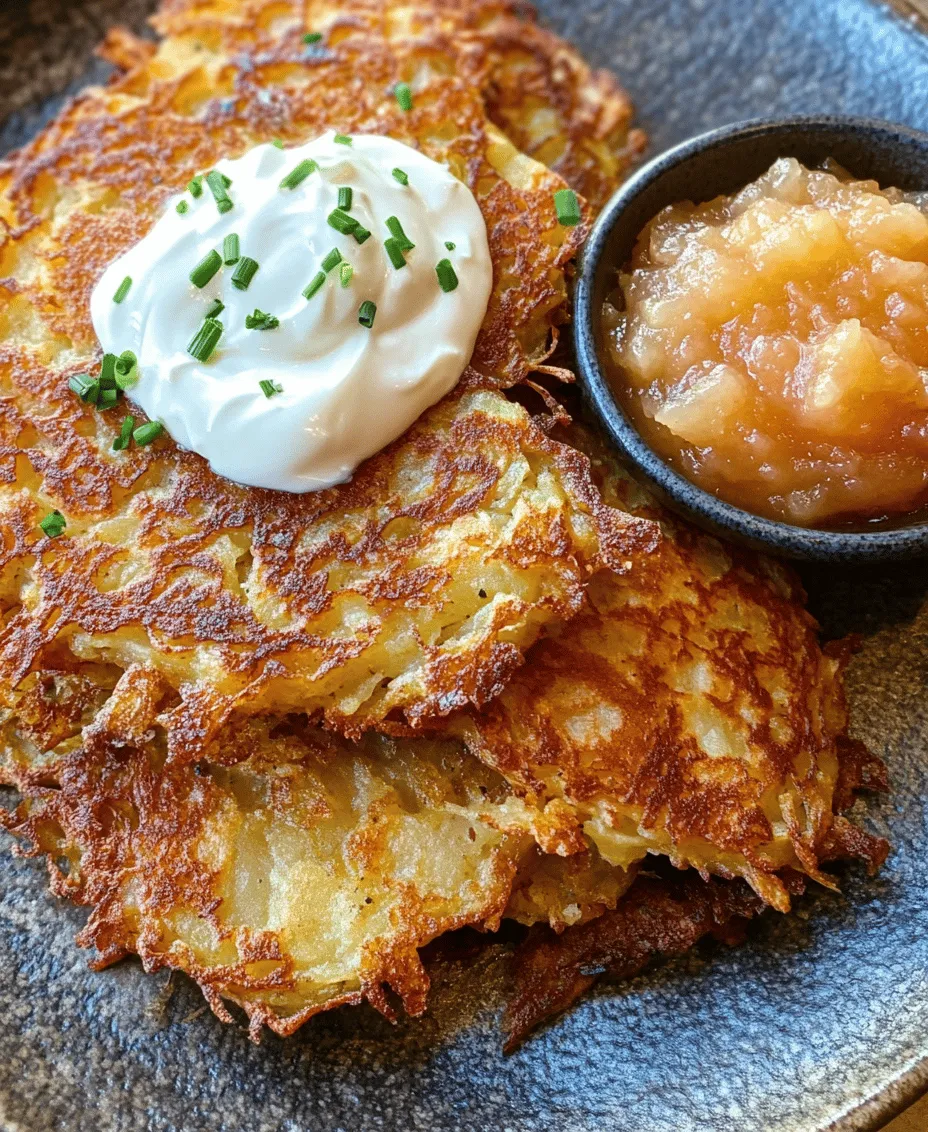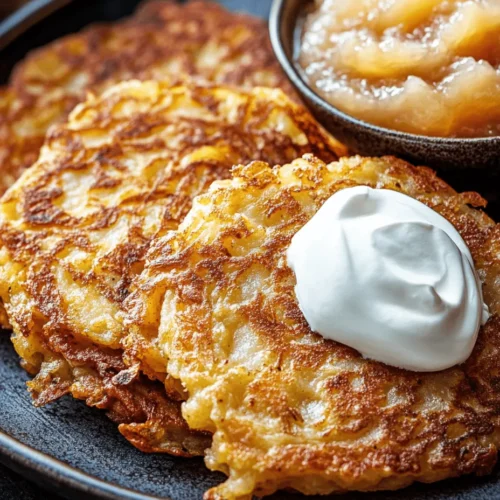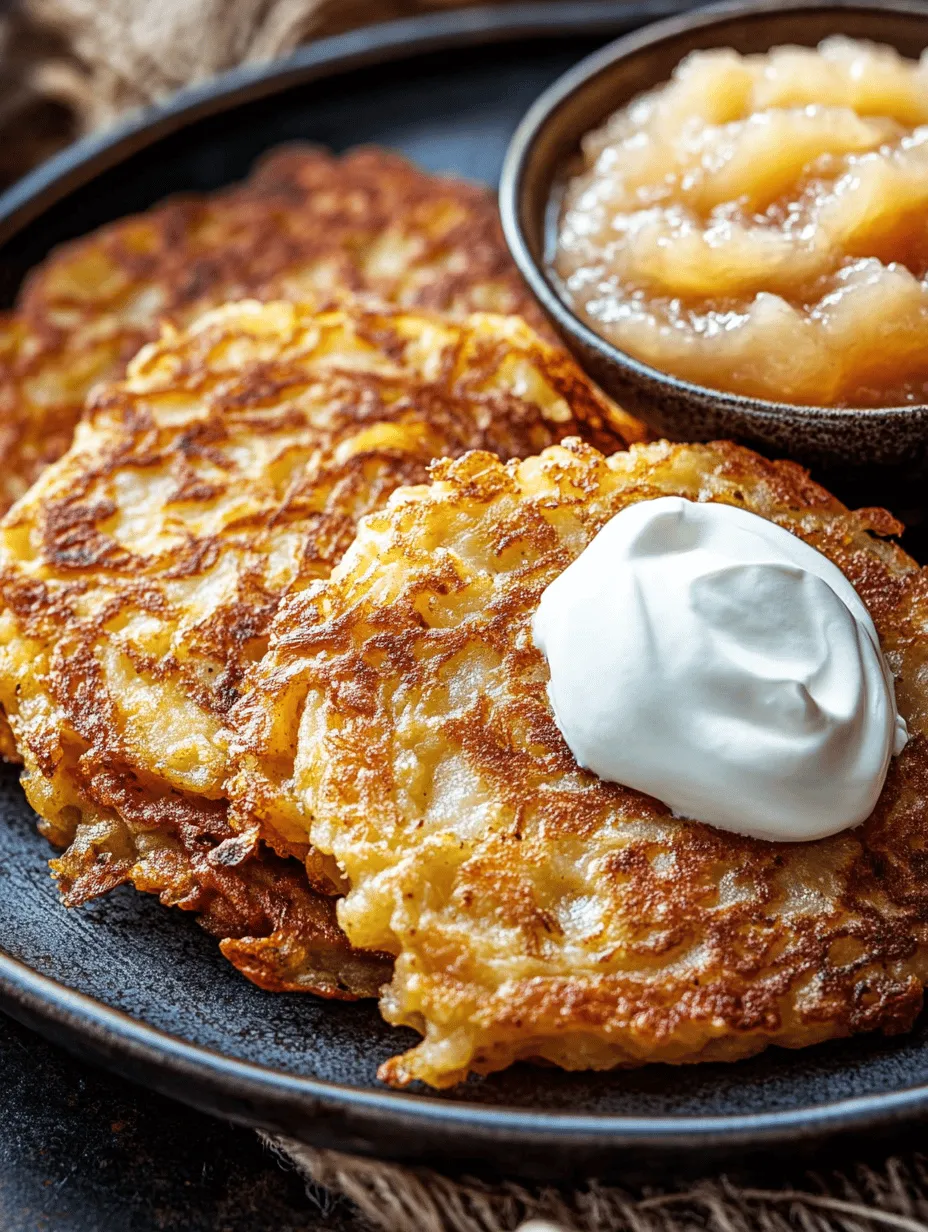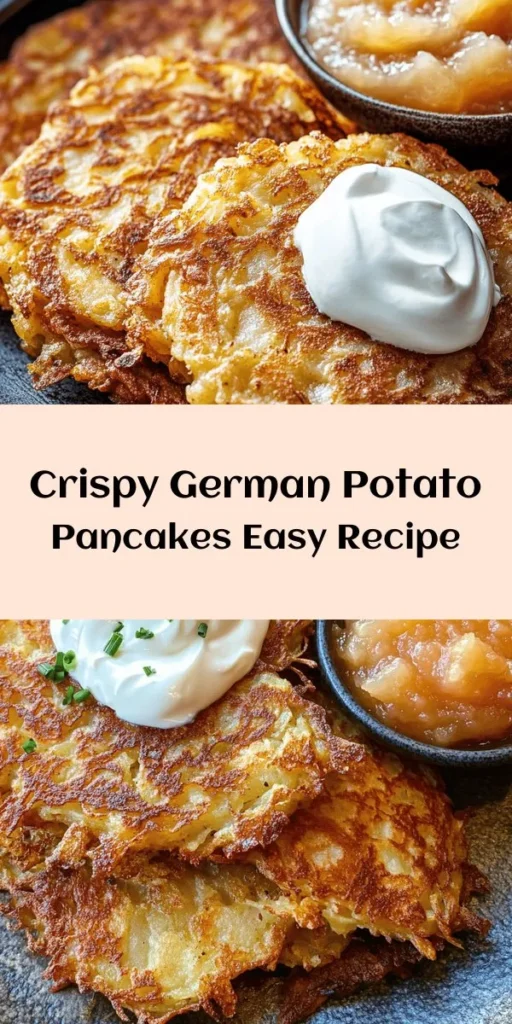Introduction
Crispy German potato pancakes, known as Kartoffelpuffer, embody the essence of comfort food in German cuisine. These delightful pancakes are not just a staple dish; they are a cherished part of family gatherings, festive celebrations, and street food markets across Germany. With their golden-brown exterior and soft, tender interior, they offer a satisfying crunch that appeals to all ages. Whether enjoyed during Oktoberfest or as a cozy meal on a chilly evening, Kartoffelpuffer have a unique ability to evoke nostalgia and warmth.
The appeal of crispy German potato pancakes lies not only in their texture but also in their simplicity. Made with a handful of basic ingredients, they are straightforward to prepare and can be customized with various toppings and sides. From savory to sweet, the possibilities are endless, making them a versatile dish for any occasion. In this article, we will explore the rich history of Kartoffelpuffer, delve into the essential ingredients that contribute to their delightful flavor, and guide you through the necessary steps to create the perfect batch of crispy potato pancakes.
Understanding German Potato Pancakes
The traditional name for potato pancakes in Germany is Kartoffelpuffer, which directly translates to “potato puffs.” This name reflects the light, airy texture that is characteristic of well-made potato pancakes. The origins of Kartoffelpuffer can be traced back to the 18th century, when they were first made as a way to utilize leftover potatoes during the harvest season. As potatoes became a staple food in Germany, the popularity of these pancakes also grew, leading to various regional adaptations.
Throughout Germany, Kartoffelpuffer are prepared differently, showcasing the diversity of this beloved dish. In the northern regions, for example, they might be served with a side of smoked salmon or herring, while in the south, applesauce or sour cream are common accompaniments. Each variation offers a unique taste experience, reflecting the local ingredients and culinary traditions. Despite these regional differences, the core concept of crispy potato pancakes remains the same, celebrating the humble potato in all its glory.
Key Ingredients and Their Roles
To achieve the perfect crispy German potato pancakes, it is essential to understand the role of each ingredient. Below is a detailed look at the key components that come together to create this delightful dish:
Russet Potatoes
Russet potatoes are the star ingredient in Kartoffelpuffer. Their high starch content and low moisture level make them ideal for achieving the desired texture. When grated, Russet potatoes produce a fluffy consistency that creates a perfect base for the pancakes. Moreover, their earthy flavor enhances the overall taste of the dish.
Onion
Onion adds depth and aroma to the potato mixture. Grated or finely chopped, onions lend their sweetness and savory notes, balancing the starchy flavor of the potatoes. A touch of onion elevates the pancakes, making them even more flavorful and enticing.
Egg
The egg serves as a binding agent, holding the mixture together and ensuring that the pancakes maintain their shape while cooking. It also contributes to the richness of the flavor. A well-beaten egg mixed with the grated potatoes and onions creates a cohesive batter that results in perfectly formed pancakes.
All-Purpose Flour and Baking Powder
Incorporating all-purpose flour into the mixture helps create structure and lightness in the pancakes. It absorbs excess moisture and aids in achieving the desired crisp texture on the outside while keeping the inside tender. Adding a pinch of baking powder can also enhance the fluffiness, making the pancakes rise slightly as they cook.
Salt and Black Pepper
Salt and black pepper are essential for enhancing the overall flavor of the potato pancakes. A generous pinch of salt brings out the natural sweetness of the potatoes, while black pepper adds a subtle heat that complements the dish. These seasonings are crucial for achieving a well-balanced taste.
Vegetable Oil
To achieve that signature crispiness, frying the pancakes in vegetable oil is vital. The oil helps create a golden-brown crust, locking in moisture while cooking the pancakes to perfection. Choosing an oil with a high smoke point, such as canola or sunflower oil, ensures that the pancakes fry evenly without burning.
Sour Cream and Applesauce
While not part of the pancake batter, sour cream and applesauce are traditional accompaniments that enhance the flavor experience. Sour cream adds a creamy, tangy contrast to the crispy pancakes, while applesauce offers a sweet and fruity balance. These toppings can be enjoyed alone or combined for a delightful medley of flavors.
Preparation Steps for Perfect Potato Pancakes
Now that we’ve covered the cultural significance and essential ingredients of crispy German potato pancakes, let’s dive into the preparation steps for creating the perfect Kartoffelpuffer.
Grating the Potatoes
The first step in making Kartoffelpuffer is grating the potatoes. To achieve the right texture, it’s crucial to use a box grater or a food processor. Here are some tips for grating potatoes effectively:
1. Choose the Right Tool: A box grater with large holes or a food processor with a grating attachment works best for this task. Both options will yield the fine shreds needed for even cooking.
2. Peel the Potatoes: Start by peeling the Russet potatoes. While some recipes may suggest leaving the skin on, peeling them ensures a smoother texture.
3. Grate Immediately: Grate the potatoes just before you are ready to cook the pancakes. Potatoes brown quickly when exposed to air, so minimizing the time between grating and cooking is crucial.
4. Drain Excess Moisture: After grating, place the shredded potatoes in a clean kitchen towel or cheesecloth and squeeze out any excess moisture. This step is essential for achieving crispy pancakes, as too much moisture can lead to soggy results.
5. Combine Ingredients: In a large mixing bowl, combine the grated potatoes with the finely chopped onion, beaten egg, flour, baking powder, salt, and pepper. Stir until the mixture is well combined and holds together.
As you prepare for the frying process, ensure your stovetop is ready and your frying pan is preheated with vegetable oil. The right frying temperature is key to achieving that coveted crispiness.
This initial phase of preparation will set the stage for creating perfectly crispy German potato pancakes that are sure to impress your family and friends. In the following sections, we will explore the frying process, tips for serving and storing, and answer some common questions about Kartoffelpuffer. Stay tuned for the delicious journey ahead!

Removing Excess Moisture: The Key to Crispiness
One of the most critical steps in preparing crispy German potato pancakes, or Reibekuchen, is removing excess moisture from the grated potatoes. When potatoes retain too much water, they become soggy during frying, leading to a pancake that lacks the desired crunch. To effectively eliminate moisture, start by grating your potatoes using a box grater or a food processor with a grating attachment. After grating, place the potatoes in a clean kitchen towel or a few layers of paper towels and twist to squeeze out as much liquid as possible.
This step not only enhances the texture of your pancakes but also allows the flavors to shine through. If you skip this process, you may end up with a dense and heavy pancake that doesn’t deliver the light, crispy experience you are aiming for.
Mixing the Batter: Ensuring a Well-Combined Mixture
Once you’ve squeezed out the moisture from the potatoes, it’s time to mix your batter. In a large mixing bowl, combine the grated potatoes with finely chopped onions, eggs, flour, salt, and pepper. The flour acts as a binding agent, helping to hold the mixture together while also adding a touch of crispiness.
To ensure an even distribution of flavors, use a fork or your hands to gently mix the ingredients. Avoid over-mixing, as this can break down the potato structure and lead to a gummy texture. Ideally, you want the mixture to be cohesive but still maintain some texture from the grated potatoes. A well-combined batter will help each pancake hold its shape during frying, resulting in a uniform golden-brown exterior.
Frying Technique: Optimal Oil Temperature and Tips for Crispy Results
Now, onto the frying! The right temperature is crucial for achieving that perfect crispy exterior. Heat a large skillet or frying pan over medium-high heat and add enough oil to cover the bottom of the pan generously. You can use vegetable oil or canola oil, both of which have high smoke points and are ideal for frying.
To test if the oil is ready, drop a small amount of the batter into the pan. If it sizzles immediately, the oil is at the right temperature. Carefully place spoonfuls of the batter into the hot oil, making sure not to overcrowd the pan. Overcrowding lowers the oil temperature, leading to greasy pancakes rather than crispy ones. Fry the pancakes for about 4-5 minutes on each side, or until they are golden brown and crispy.
Once fried, transfer the pancakes to a plate lined with paper towels to drain excess oil. This will help maintain their crispiness while you continue frying the remaining batter.
Serving Suggestions: Presentation and Garnishing Ideas
Crispy German potato pancakes can be served in a variety of ways, making them not only delicious but also visually appealing. For an authentic experience, serve them hot with a dollop of sour cream and a sprinkle of freshly chopped chives or parsley. This adds a fresh flavor and a pop of color to your dish.
For a sweet twist, consider serving potato pancakes with homemade applesauce or a side of lingonberry jam. The combination of the savory pancakes with a touch of sweetness creates a delightful balance. Additionally, you can serve them alongside a simple green salad dressed with a light vinaigrette to add a refreshing contrast to the meal.
Tips for Achieving Crispy Texture
To achieve an outstanding crispy texture, consider these essential tips:
1. The Science Behind Frying: The Maillard reaction is what gives fried foods their beautiful golden color and rich flavor. This chemical reaction occurs when proteins and sugars in the food are exposed to high heat, creating that desirable crispy crust.
2. Don’t Overcrowd the Pan: As mentioned earlier, overcrowding the pan will lower the temperature of the oil, leading to greasy pancakes. Fry in batches if necessary to maintain the heat.
3. Adjust Oil Temperature: Keeping the oil at a consistent temperature is crucial. If the oil is too hot, the pancakes will burn on the outside while remaining uncooked on the inside. If it’s too cool, they will absorb too much oil. Aim for a temperature between 350°F and 375°F.
Common Mistakes to Avoid
While making crispy German potato pancakes may seem straightforward, there are some common pitfalls to avoid:
– Using Too Much Moisture: As previously discussed, failing to squeeze out excess moisture can lead to soggy pancakes. Be diligent in this step for the best results.
– Not Allowing Enough Frying Time: Rushing the frying process can result in pale, undercooked pancakes. Be patient and allow each side to brown sufficiently before flipping.
– Skipping the Draining Step After Frying: After frying, always place pancakes on paper towels to absorb excess oil. Skipping this step can make your pancakes limp and greasy.
Nutritional Information
Crispy German potato pancakes not only delight the palate but also provide a balanced nutritional profile. A typical serving (two pancakes) contains approximately:
– Calories: 250-300
– Fat: 15-20g (varies based on oil used)
– Carbohydrates: 30-35g
– Protein: 6-8g
– Fiber: 2-3g
The balance of carbohydrates from the potatoes, protein from the eggs, and healthy fats from the oil creates a satisfying dish. While potato pancakes are indulgent and delicious, they can be enjoyed as part of a balanced diet when paired with vegetables or served alongside a salad.
Variations and Serving Ideas
There are numerous regional variations of potato pancakes that incorporate different herbs and spices. For instance, adding fresh dill or parsley can enhance the flavor profile significantly. You might also consider incorporating grated zucchini or carrots for a colorful twist.
Beyond the traditional accompaniments of sour cream and applesauce, think creatively about how to serve these pancakes. Try topping them with smoked salmon and crème fraîche for a gourmet twist or pair them with a tangy sauerkraut for a delightful contrast. They also make an excellent base for a poached egg, creating a hearty brunch option.
Conclusion
The joy of making and enjoying crispy German potato pancakes is something every home cook should experience. This comforting dish, with its delightful crunch and rich flavors, celebrates the essence of German cuisine. Whether enjoyed as a snack, side dish, or main course, these pancakes are versatile and satisfying.
We encourage you to try making this dish at home, experimenting with different flavors and serving ideas. With the right techniques and a bit of practice, you can master the art of crafting the perfect crispy potato pancake that will impress family and friends alike. Embrace the warmth and comfort of this classic recipe, and let the delightful flavors transport you to a cozy German kitchen.



